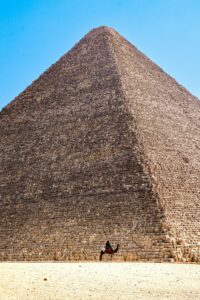The Pyramids of Egypt are the most enduring symbols of ancient civilization worldwide. They epitomize great engineering feats, architectural masterpieces, and cultural heritage. Thousands of years old, these spectacular structures have inspired people worldwide and brought millions of tourists every year to Giza and other places. Here is an inside view of Egypt’s pyramids, their history, construction, and mysterious features, together with key facts that open up more about their great legacy.
A Glimpse into History
The pyramids were built as elaborate tombs for Egypt’s pharaohs and high-ranking officials, mainly during the Old Kingdom (2686–2181 BCE). They ensured eternal life for the deceased since the ancient Egyptians believed in life after death. The Pyramid Age began with the Step Pyramid of Djoser, constructed during the Third Dynasty by the brilliant architect Imhotep. The structure, located at Saqqara, represented a new beginning and marked the transition from mastabas to more complex designs. The Pyramid Age’s peak was during the Fourth Dynasty, when the Great Pyramid of Giza was constructed by Pharaoh Khufu around 2570 BCE.

Key Facts About the Egyptian Pyramids
The Great Pyramid of Giza
The Great Pyramid, known also as the Pyramid of Khufu or Cheops, is the tallest among the Giza pyramids and one of the Seven Wonders of the Ancient World. The original height of this great pyramid was 146.6 meters, or 481 feet tall, but erosion has taken some height off it, now only 138.8 meters, or 455 feet.
The pyramid consisted of about 2.3 million limestone blocks, weighing between 2.5 and 15 tons apiece.
The Sphinx and Surrounding Pyramids:
It also has on it the Pyramid of Khafre, a bit smaller than the Great Pyramid, and the Pyramid of Menkaure, which is the smallest.
The Great Sphinx of Giza is a giant limestone statue intended in the shape of half lion and half pharaoh, lying guard along the side of the pyramids.
Astronomy Alignment:
In aligning the pyramids with cardinal points—in other words, north, south, east, and west—they are believed by many astronomers to be astronomically important and possibly so reflective of stars in the Orion constellation. 
Construction Methods:
It remains the biggest subject of discussion and infatuation, the construction of pyramids. Ancient builders shifted and positioned their heavy stones through ramps, sledges, and sheer human power; still, modern engineers are surprised at how precise and massive the works of the ancient ones are.
Secret Chambers and Secrets:
Ground-penetrating radar and muon tomography revealed that the pyramids have some hidden voids and chambers behind them, which remain a thoroughly under-investigated and interpreted area.
Cultural and Religious Significance The pyramids represented an idea of monumental tombs showing the belief in the afterlife of the ancient Egyptians and also their will to honor and preserve the souls of the dead. The pyramids belong to a larger funerary complex, which includes temples, causeways, and also several smaller satellite pyramids constructed for queens and consorts.
The pyramids also symbolized the divine power of the pharaoh and his connection to the gods, especially Ra, the sun god. The sloping sides of the pyramids represented the rays of the sun, which would help the pharaoh ascend into the heavens.
Difficulties and Conservation
The pyramids have withstood the test of time and natural erosion, theft, and human interference for thousands of years. Most of the original casing stones that covered the pyramids were removed for use in other construction projects, leaving only the core stones exposed.
Currently, the government of Egypt and other institutions such as UNESCO are actively involved in its protection. They conduct several forms of control measures on tourism activities, legal restrictions of unlawful excavation sites, and making use of modern technological means of maintaining the area. Modern Charms and Secrets Pyramids will always be a source of fascination for many historians, archaeologists, and enthusiasts around the world. They are shrouded in mystery—perhaps their methods of precision construction, treasures still hidden, and even astrological importance. Popular culture and media have further sparked a desire in the pyramids as gateways to ancient secrets and mysteries. Despite advancements in research, many questions still remain unanswered, thereby adding to their allure.
Conclusion
The Pyramids of Egypt stand as monuments to human ingenuity, ambition, and spirituality forever. They are not tombs but a window into the understanding that the ancient Egyptians had for their architecture, astronomy, and cultural beliefs. As one of the most recognizable and most enduring symbols of ancient history, the pyramids inspire awe, curiosity, and respect for the achievements of a civilization that thrived thousands of years ago.



